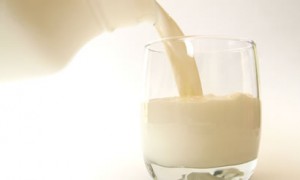 I was out picking up our load of raw milk and grass fed beef directly from the farm the other day and got some exciting news. James Nors the owner of Nors Dairy was sharing with me his newest experiment, using raw milk as a fertilizer. He explained to me this is nothing new and some farmers have been doing it for over 10 years. I did some research and found the original published article James was referencing, which I have republished later in this article. James has sprayed some of his fields with the raw milk to test its results, in addition to treating his vegetable growing areas.
I was out picking up our load of raw milk and grass fed beef directly from the farm the other day and got some exciting news. James Nors the owner of Nors Dairy was sharing with me his newest experiment, using raw milk as a fertilizer. He explained to me this is nothing new and some farmers have been doing it for over 10 years. I did some research and found the original published article James was referencing, which I have republished later in this article. James has sprayed some of his fields with the raw milk to test its results, in addition to treating his vegetable growing areas.
In the vegetable plants that were treated, he noticed that in a couple of days that the plants leaves took on a deeper green along with an increase in growth. As soon as I could I applied the raw milk and water mixture to our own home garden. It has been a week and we too noticed increased growth. The tomato plants grew at least half a foot in just under a week and filled out a lot. The cucumber plants have become bushes. I purposely did not treat one of the cucumber plants and it is 30-40% smaller than the milk fed ones.
Here are some of the details of my use, 3:17 ratio of raw milk to water applied using a hand held spray bottle, once every 7 days. I first soak the ground by watering the plants well, with just water, and then apply the raw milk water mixture spraying the soil and leaves of the plants. I will keep you posted with updates as we continue the process.
Do leave your comments on how this is helping your garden!
UPDATE: Our dogs sure can smell the milk mixture after it is sprayed, we have to keep them out of the garden area, 🙂 They already get their daily small bowl of raw milk, better than milk-bones.
Well, below is the article with more of the story and details. Enjoy – Jeff
This article appeared in the March 10, 2010, issue of the Unterrified Democrat, a weekly newspaper published in Linn, Mo., since 1866. In addition to writing for the paper, Voss raises registered South Poll cattle on pathetically poor grass that he is trying desperately to improve.
Nebraska dairyman applies raw milk to pastures and watches the grass grow
An Illinois steel-company executive turned Nebraska dairyman has stumbled onto an amazingly low-cost way to grow high-quality grass – and probably even crops – on depleted soil.
Can raw milk make grass grow? More specifically, can one application of three gallons of raw milk on an acre of land produce a large amount of grass?
The answer to both questions is yes.
Call it the Nebraska Plan or call it the raw milk strategy or call it downright amazing, but the fact is Nebraska dairyman David Wetzel is producing high-quality grass by applying raw milk to his fields and a Nebraska Extension agent has confirmed the dairyman’s accomplishments.
David Wetzel is not your ordinary dairyman, nor is Terry Gompert your ordinary Extension agent. Ten years ago Wetzel was winding up a five-year stint as the vice president of an Illinois steel company and felt the need to get out of the corporate rat race. At first he and his wife thought they would purchase a resort, but he then decided on a farm because he liked to work with his hands. The Wetzels bought a 320 acre farm in Page, Neb., in the northeast part of the state, and moved to the farm on New Year’s Day in 2000.
“We had to figure out what to do with the farm,” Wetzel said, “so we took a class from Terry Gompert.” They were advised to start a grass-based dairy and that’s what they did. “There’s no money in farming unless you’re huge,” Wetzel said, or unless the farmer develops specialty products, which is what they did.
In their business, the Wetzels used the fats in the milk and the skim milk was a waste product. “We had a lot of extra skim milk and we started dumping it on our fields,” Wetzel said. “At first we had a tank and drove it up and down the fields with the spout open. Later we borrowed a neighbor’s sprayer.”
Sometime in the winter of 2002 they had arranged to have some soil samples taken by a fertilizer company and on the day company employees arrived to do the sampling, it was 15 below zero. To their astonishment they discovered the probe went right into the soil in the fields where raw milk had been applied. In other fields the probe would not penetrate at all.
“I didn’t realize what we had,” Wetzel said. “I had an inkling something was going on and I thought it was probably the right thing to do.” For a number of years he continued to apply the milk the same way he had been doing, but in recent years he has had a local fertilizer company spray a mixture that includes liquid molasses and liquid fish, as well as raw milk. In addition he spreads 100 to 200 pounds of lime each year.
Gompert, the extension agent that suggested Wetzel start a grass-based dairy, had always been nearby – literally. The two are neighbors and talk frequently. It was in 2005 that Gompert, with the help of university soils specialist Charles Shapiro and weed specialist Stevan Kenzevic, conducted a test to determine the effectiveness of what Wetzel had been doing.
That the raw milk had a big impact on the pasture was never in doubt, according to Gompert. “You could see by both the color and the volume of the grass that there was a big increase in production.” In the test the raw milk was sprayed on at four different rates – 3, 5, 10 and 20 gallons per acre – on four separate tracts of land. At the 3-gallon rate 17 gallons of water were mixed with the milk, while the 20-gallon rate was straight milk. Surprisingly the test showed no difference between the 3-, 5-, 10- and 20-gallon rates.
The test began with the spraying of the milk in mid-May, with mid-April being a reasonable target date here in central Missouri. Forty-five days later the 16 plots were clipped and an extra 1200 pounds of grass on a dry matter basis were shown to have been grown on the treated versus non-treated land. That’s phenomenal, but possibly even more amazing is the fact the porosity of the soil – that is, the ability to absorb water and air – was found to have doubled.
So what’s going on? Gompert and Wetzel are both convinced what we have here is microbial action. “When raw milk is applied to land that has been abused, it feeds what is left of the microbes, plus it introduces microbes to the soil,” Wetzel explained, adding that “In my calculations it is much more profitable (to put milk on his pastures) than to sell to any co-op for the price they are paying.”
Wetzel has been applying raw milk to his fields for 10 years, and during that time has made the following observations:
* Raw milk can be sprayed on the ground or the grass; either will work.
* Spraying milk on land causes grasshoppers to disappear. The theory is that insects do not bother healthy plants, which are defined by how much sugar is in the plants. Insects (including grasshoppers) do not have a pancreas so they cannot process sugar. Milk is a wonderful source of sugar and the grasshoppers cannot handle the sugar. They die or leave as fast as their little hoppers can take them.
* Theory why milk works. The air is 78% nitrogen. God did not put this in the air for us but rather the plants. Raw milk feeds microbes/bugs in the soil. What do microbes need for growth? Protein, sugar, water, heat. Raw milk has one of the most complete amino acid (protein) structures known in a food. Raw milk has one of the best sugar complexes known in a food, including the natural enzyme structure to utilize these sugars. For explosive microbe growth the microbes utilize vitamin B and enzymes. What do you give a cow when the cow’s rumen is not functioning on all cylinders (the microbes are not working)? Many will give a vitamin B shot (natural farmers will give a mouthful of raw milk yogurt). Vitamin B is a super duper microbe stimulant. There is not a food that is more potent in the complete vitamin B complex than raw milk (this complex is destroyed with pasteurization). Raw milk is one of the best sources for enzymes, which break down food into more usable forms for both plants and microbes. (Again, pasteurization destroys enzyme systems.)
* Sodium in the soil is reduced by half. I assume this reflects damage from chemicals is broken down/cleaned up by the microbes and or enzymes.
* If you choose to buy raw milk from a neighbor to spread on your land, consider offering the farmer double or triple what he is paid to sell to the local dairy plant. Reward the dairy farmer as this will start a conversation and stir the pot. The cost for the milk, even at double or triple the price of conventional marketing, is still a very cheap soil enhancer.
* Encourage all to use their imagination to grow the potential applications of raw milk in agriculture, horticulture and the like – even industrial uses – possibly waste water treatment.


I have been spraying raw milk and love it but one thing I am not sure about is when to spray. Should I spray in the evening or morning? Thanks!
Rochelle, I sprayed with the raw milk on the soil in the later day thinking that it might sink into the soil and not evaporate as much. Just my feeling. – Jeff
Thanks, Jeff! That makes sense. I am going to give them some tomorrow.
I’m wondering if you have ever tried using the juice from fermented veggies as a fertilizer? Not sure what that might do to the soil…? Thanks for the great info!
We have not tried using fermented veggies as fertilizer. We eat all our veggies. Might be something to try, let me know if you do. 🙂